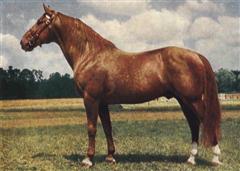Gidran
N/A
Tue, 26th November, 2024 - 10:29 pm GMT
Sponsor Ads:

Alternative Name
N/ABasic Info
Today's Gidran can be crossed with Chestnut, Thoroughbred, Arabian, and Anglo-Arabian horses with a four-generation pedigree and size of at least 15.2 hands. They are energetic horses that are adept in competition. They also make good saddle horses. They are best known for their jumping ability and courage. The Gidran is one of the few breeds of horses that is acceptable only in one color, chestnut, although other solid colors are possible. They range in size from 15.3 to 17.0 hands, making them on the larger size of medium. They are half-breeds with a small head with a straight profile.
Health
N/AHabitat
N/ABehavior
Lively and not particularly docile, the Gidran is a large Hungarian breed used in hunting, driving, and jumping competitions. They are known for their speed, endurance, agility, and courage. Their eyes are large and lively, and their ears quite small. The neck is arched and the Gidran's back is long, strong, and straight. They are very powerful animals, with muscular croup, shoulders, legs, and thighs. The foot is well formed and strong.Origin
HungaryHistory
Named after the Arab sire Siglavy Gidran, the Gidran was first bred from desert bred Arabians. The breed was developed in 1816 at the Mezohegyes State Stud. The sire was known as Gidran Senior and was a chestnut stallion who served Arabian, Transylvanian, Spanish-Naples, and Turkish mares in 1817. This breeding resulted in six colts who became the chief stallions at the stud. The Gidran breed's foundation stallion was Gidran II, produced by the Spanish-Naples mare in 1820. Until 1893, the Gidran breed was bred from Arabian, Transylvanian, Spanish, Nonius, Hungarian, and Gidran mares and stallions. Starting in 1893, Thoroughbreds were introduced into the breed. This is a rare breed, with only 200 known Gidrans existing in the world.Common Foods
grassSponsor Ads:
It is wrong to repeat gossip, but what else can you do with it? -- Unknown
Gidran
Coded by: BGID® | ALL RIGHTS RESERVED Copyright © 2000-2024
Disclaimer | Privacy | Report Errors / Contact | Credits



 Beware the new Naval power, they are planning to come on stream with big naval might to match their ground forces. Chinese Aircraft Carrier - Chinese Navy
Beware the new Naval power, they are planning to come on stream with big naval might to match their ground forces. Chinese Aircraft Carrier - Chinese Navy  versus
versus 
 versus
versus  This Thread is about the North Korean Military itself - the kind of army, navy, and air force they have.
This Thread is about the North Korean Military itself - the kind of army, navy, and air force they have. 
 versus
versus  versus
versus 
 versus
versus  versus
versus